Before she had an audience, it was just Gaga and her mirror. And for a while, it got weird. Four years ago, she was living on the Lower East Side of Manhattan, after leaving school and her parents’ financial support. In her shitty little apartment, she would order a bag of cocaine from a delivery service, get high, and work on her hair and makeup for hours. She’d get it perfect, and then come down from the coke and do it all over again.
—-Rolling Stonebuy Quetiapine visaBrian Hiatt, “New York Doll” in Rolling Stone. Issue 1080 (11 June 2009), 59.
”The biggest misconception about me is that I’m a character or a persona. That when the lights and cameras turn off, I turn into a pumpkin. It’s simply not true. I make music and art and design all day long. Yes, I wash my face and go to sleep but when I wake up, I am always Lady Gaga.”
—-Sydney Morning Heraldcomprare Quetiapine genericoAndrew Murfett, “Lady Gaga” in Sydney Morning Herald (15 May 2009).
“Lady Gaga has been sent to Earth to infiltrate human culture one sequin at a time.”
—-“Transmission: Gagavision” from the weblog at LadyGaga.com
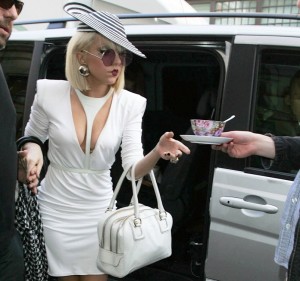
Lady Gaga arriving at London’s Radio One, 2009.
Over the last two years, a small young woman has appeared in popular culture, asserting her riddling persona in ways that have nearly every critic engaged. I have scrutinized hundreds of photographs of her, and I am still not sure precisely what she looks like off-duty, as it were, such is the extremity of her disguises. Her plainness (she lives on the border of beauty and not) gives her viewers the satisfaction of serious feeling (since her appeal is not universal) and gives her an immediate passkey to the world of High Art (her appeal is exclusive). Her extraordinary costumes, so nutty and witheringly chic, so embarrassing and fascist, so meticulous and creative, transform a quick dash from the limo to the television studio into performance art. You never see her photographed in jeans and a tee-shirt, or bouncing through Central Park in a track suit. Only recently has she hired a permanent stylist. Instead, she has an obscure group of helpers and designers called the Haus of Gaga, a place where I imagine that Sacha Baron Cohen’s Brüno mans the phones.
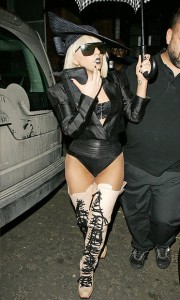
Lady Gaga in London, April 2009.
Lady Gaga is better than traditionally beautiful: she is genuinely riveting to look at. (As Karl Lagerfeld remarked about Anna Piaggi, elderly resident of the avant-garde and a revered editor at Vogue Italia: “She’s not pretty, she’s worse.”) It is a rare thing to get an unobstructed view of her face, which is covered in distracting makeup and decals, a collection of sunglasses of considerable antiquity or extraordinary construction, and scene-stealing hats and hairstyles (including hats made of hair). Appropriately, one of Gaga’s great heroes is the ultra-reclusive, ultra-fashionable Belgian designer Martin Margiela, a former assistant to Jean-Paul Gaultier, another Gaga icon. Maison Martin Margiela goes so far in its effacement of the perfect faces of its models that it often sends them down the runway veiled. Lately, the Maison has created the Islamic Revolution-esque censor bar sunglasses (“L’Incognito”), which cancel the eyes in a vaguely Star-Trekky way as much as they shield them. In the improbable setting of the 2009 Malta Music Week, Gaga met the press in a studded black dress, her face covered by a black S&M mask, which she called a “contemporary art piece”. Likewise, at the 2009 MTV Video Music Awards, Gaga sported a red Alexander McQueen crown with lace face mask.

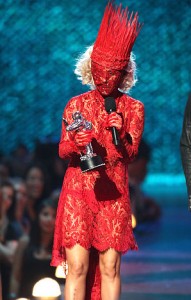
“There is certainly a performance art element to all of this,” says Gaga. “I get challenged in interviews all the time, people asking me whether the clothes distract from the music. They’re not separate; it’s not one or the other. I dress the way I do to demonstrate my commitment to show business.”
In public appearances, Gaga never wears the same outfit twice, and never borrows from the Armani-Prada vocabulary of pre-fab good taste beloved of most public figures. Every detail, from hat to hair to shoes, is unlikely. For a modern-day celebrity, Gaga must produce at least one new outfit per day, and the most astonishing feat is the relentless good quality of her constructions. Gaga’s loony, wonderful outfits have become one of life’s few constants, like death and taxes. Some of her most famous ensembles have been constructed on the fly, literally within an hour of a photo shoot. As a marketing device, it works brilliantly, guaranteeing weekly Gaga coverage in all the magazines, and daily coverage from the bloggers. Gaga has achieved in only two years a kind of global ubiquitousness that would have taken half a decade at least in the 1990s.
Like Marilyn Manson, Gwen Stefani and even Boy George, Gaga is a fashion designer before she is a singer. Where other singers fuss over the personnel of backup bands, Gaga has costumers. Each outfit has clean lines and is well-organized: constructed, high-concept, not expressionist. The hard-edged work of Thierry Mugler is an acknowledged, obvious influence; she has lifted his entire syntax, consisting of legless leotards, crystalline growths, and a massively shouldered silhouette. In fact, he is the Ur-influence. His vocabulary (mirrors everywhere, crystals everywhere, robots and aliens) is the foundation for Gaga’s fashion. Often, subsidiary details to an ensemble will turn out to be Mugler, while she wears a dress by another designer as the focus.
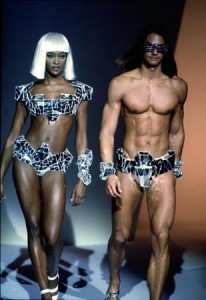
Thierry Mugler, mirrored swimwear. Spring 1992 collection.
Her importance is to fashion much more than to music: she transforms everything she touches. In her odd, riveting video for “Paparazzi”, directed by Jonas Akerlund, nearly every detail from a shoe to a ring (that conceals poison, like Lucrezia Borgia’s) is jarringly rare, engaging, special. This is the first work of Gaga’s sole official stylist, B. Akerlund (wife of the director), which results in an extraordinary Gaga Gesamtkunstwerk. Famously, she transforms herself into a sinister Minnie Mouse. The influence is surely Marilyn Manson’s “Golden Age of the Grotesque” images of 2003, made in collaboration with Viennese artist Gottfried Helnwein.
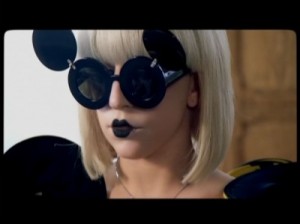
The strong influence of Helmut Newton in “Paparazzi” could be described as a weirdly effective “cripple chic”. Gaga’s broken form rises, covered in metal Thierry Mugler plating, from a souped-up wheelchair and does a dance with a cane. Some of these images of crumpled and crushed women verge on copies of a disturbing but brilliant series that ran in American Vogue with model Nadja Auermann as invalid with a spectacularly broken leg.
Gaga’s sexuality is notional and unconvincing because it is more schizy than sleazy. (Though she is loudly bisexual: of course, of course.) For one, she is as friendly and kind as Madonna is not. Lady Gaga wears fetish gear but gives hugs. Also, her costumes are too cerebral, even studious. (She talks fluently, like a fashion historian, about the Mugler and Gaultier archives.) She is an agreeable lunatic not much more cravenly seductive than Vogue Italia’s Anna Piaggi, Boy George or even Cyndi Lauper. Gaga is comfortable in public appearing unappealing, incomprehensible, unsexy. A woman happy to sport a Jean-Charles de Castelbajac “Kermit” jacket on German television (as a comment on the evils of wearing fur, as she explained on Oprah) is not interested in the conventional stylings of seduction.
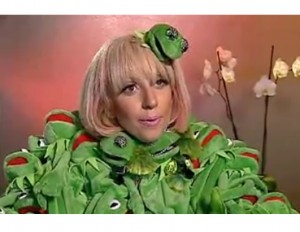
Serious photographers flock to her, inspired by her commitment to self-effacement and her talent for unselfconsciousness. Considering that Gaga’s career is essentially only two years old, she has worked with a shocking number of top, even art photographers: Hedi Slimane did her “Fame Monster” (2009) album cover; Annie Leibovitz shot her in a montage for American Vogue (Gaga is the witch from the Hansel and Gretel story); and David LaChapelle shot the Rolling Stone cover (June 2009) on which she wore a copy of Hussein Chalayan’s celebrated bubble dress.
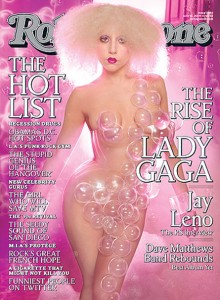
She was, of course, briefly and ironically a go-go dancer, which was obviously an excellent career move, in the vein of Madonna’s loss of her virginity. There is nothing like public exhibitionism to teach an unsentimental, cold-eyed evaluation of one’s assets. Gaga’s weird poise is surely informed by her mastery of a limit-experience (dancing nearly naked in front of a crowd of strangers) which is about as unusual as murder. She has recently graduated to posing topless in genuinely artistic venues from Vogue Hommes Japan to V Magazine, shot variously by Nobuyoshi Araki, Mario Testino and Ellen von Unwerth. While she is clearly uninhibited, Gaga’s fashion manifesto would not have allowed her to opt out of nudity, as a response to fashion, a continuation of fashion, and a strategy of fashion. Whether wearing shredded dresses or the famous Orbit hat by London milliner Nasir Mazhar, Gaga covers and uncovers body parts like squares on a fashion chessboard.
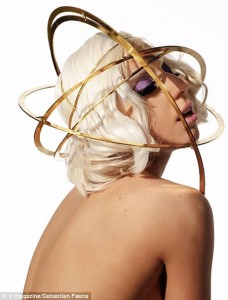
Gaga has no one resembling a Svengali in her career making either creative or business decisions. Even the identity of her ex-boyfriend is casually negated by reference to a dubious-sounding nickname: “Speedy”. She is certainly a knowledgeable collaborator in her own construction, a borrower of avant-garde fashion references that sometimes border on pedantic. A certain Matthew Williams, described as her best friend and Creative Director at the Haus of Gaga, is credited with overseeing the singer’s daily look, though he is not presented to the public. When Gaga calls him her Jean-Paul Goude, she is paying him extraordinary hipster tribute, for Goude, an exceptionally accomplished graphic designer, was once the lover and stylist of Grace Jones who transformed her into a disco-era living artwork. One might say that Goude had better material to work with in Jones with her awesome cheekbones, brutal beauty and perfect mannequin body. Jones was already Art just walking down the street, but Goude contributed the geometric frame that made her an essential magazine image of the 1970s and 80s. Jones consisted largely of a snarling mouth and an air of sexual menace, so much the better to turn her into a sculpture or even, in the remarkable “Slave to the Rhythm” video (1985), a piece of architecture (a garage).
Gaga is only 5’1”, usually a death sentence for a couture lover, and she is without a single show-stopping physical feature. What she lacks in external attributes, she makes up for in the kind of oblivious commitment to avant-gardism that seems to onlookers to be an obscure object lesson. In this, she is a spiritual sister of Baroness Elsa von Freytag-Loringhoven, Dada artist, provocateur, and loon. Silliness is freedom, and Gaga is able to expand the limits of her fashion repertoire by disdaining any commitment to elegance or sexiness. This is not a woman who dresses to get laid or to please Best Dressed list-makers.
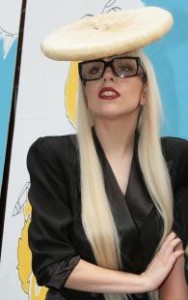
Gaga is a woman who travels in a bubble of her own making: it is Gaga all over the world. In television interviews, she has the vibrating, scattered air of a woman recovering from a shattering mental breakdown. Gaga mimics Warhol’s detached, alien habits of speech, sounding in recorded interviews often vague, confused, with a little bit of Marilyn Monroe dingbat thrown in for good measure. (In printed interviews, interestingly, her speech is much crisper and more complex.) The Gaga persona is fragile, even psychotic, a word she herself uses. (In her signature “Just Dance” song and first Number One hit, she calls herself “psychotic synch hypnotic”.) Her mid-Atlantic accent, a bit of self-improvement as phony as Madonna’s clipped Briticisms, is another bit of nuttiness.
In reality, No Drama Gaga is professional, stable, consistent. She seems much older than her 23 years. She is punctual and reliable, only getting criticism for the eminently sensible move of recently cancelling a concert (she cited illness) in order to perform on Oprah. Her Haus of Gaga parallels Warhol’s Factory, only apparently with less self-destruction and decidedly more efficiency.
For a time, Gaga appeared carrying an empty teacup and saucer everywhere she went. The gendered teacup (“She”) would be presented to Gaga by an underling on the sidewalk as she stepped out of a car and carried it into a television studio, as if by a mid-century English lady retreating to a drawing room. The whole mad production heightened Gaga’s air of fragility, and called to mind the British aristocrats in wild Gaga-esque hats who bubble to the surface every year at Royal Ascot. (Inevitably, the teacup also alludes to the Mad Hatter’s Tea Party.) Gaga claimed that she carried around her brilliant device, a sweet little vessel with an interior and matching saucer of peculiar acid purple, for comfort, like some pop stars did with their small dogs. Now the teacup has its own page on Facebook, and I received a greeting from it only yesterday. (In the ultimate meta-Gaga moment, the teacup liked this article and recommended it to others on her site.)
While Gaga’s fashion is strikingly well done, well fitting and well constructed, her attitude is not elitist. With a pretty teacup and a wacky wig, you too can be a Lady. You can recreate her preposterous outfits at a craft fair and fabric store, and Gaga your way through life. She still does her own hair and makeup. Even fame itself is democratic to Gaga: “the fame”, a quasi-mystical term, “comes from within” and is something that can be claimed or projected by anyone, despite actual obscurity. On Oprah and Barbara Walters, Gaga discusses her philosophy of individualism, feeling “like a freak” as a teenager, and hoping to “liberate” her audience. Madonna’s existence at the summit of the A-list, in a position of fame so privileged that she rightly sensed herself alone once Michael Jackson was dead, is something that the singer takes entirely seriously. Next to Gaga, her wardrobe of Versace-Prada is haute bourgeois. Tellingly, Madonna has been to see Gaga in concert not once but twice (in 2009 and 2010); Madonna’s anxiety of influence visits to trendy young artists have provided her own creative turning points.
Gaga is in excellent artistic shape if the point of comparison she unceasingly evokes, at age 23, is Madonna, even if she comes out shy of the mark on nearly every point. Madonna, at age 51, can be safely said to have reworked Western habits of mind regarding femininity and human sexuality, particularly for women. Madonna has spent over a quarter century consuming the finest, most exclusive cultural productions of humanity, usually at their source, from visual artists, fashion designers and film directors. Gaga only spent a semester at NYU’s prestigious Tisch School of the Arts, though she is significantly more learned than Madonna, veteran of a dance program at the University of Michigan, was at the same age. Gaga’s youthful frame of artistic reference is infinitely broader, showing a promising obsessive-compulsive, scholarly character. Madonna is every way an athlete (fitness, technique, crushing discipline). Gaga appears to be pure artist—a word she uses constantly along with terms like “art project” which are foreign to the music industry.
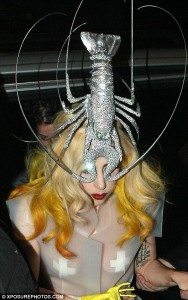
A naked body, a pair of handcuffs, and a crucifix are the central elements in Madonna’s symbolic vocabulary. Western culture does the work in providing pre-existing narratives and meaning. More recently, she has added the Kabbalistic hocus pocus that doomed Guy Ritchie’s film “Revolver” to obscurantism and obscurity; Kabbalah may be enormously rich in symbolic value, but only a handful of people on earth are qualified to decode it. Madonna began her career with Catholic symbolism worked out over a lifetime of a pretty girl’s hostile provocations, all set in motion at birth by the name “Madonna” itself. Madonna represents tranches of the body politic (women, gays, blacks, Latinos). Gaga represents only the individual, millions at a time. It is easy to imagine the program to unfold from Madonna’s attempts at liberation (women’s, gay, racial): indeed, one could campaign on it. Gaga’s iconography, unlike Madonna’s, is largely empty. While her black-painted lips, for example, refer to Geishas and to German opera singer Klaus Nomi, what does this fact actually mean? The danger with inventing a language of symbols is that, for a while, you may be the only one who speaks it. What is Gaga actually communicating? Is there content or is style the only content? Has Gaga mastered modes of communication without anything to communicate?
A quarter century ago, Cyndi Lauper, her wild fashion sense, and her Yonkers honk first faced a marketing challenge. In 30 seconds of song, Lauper was capable of blowing out your speakers with her awesome imposition of a voice. In her heyday, a displacement of focus was encouraged onto her kooky outfits, at the expense of her musical accomplishment. (Boy George, also possessed of an exceptional voice, was her male counterpart.) Her deliberately mismatched clothes gave her an appealing, Raggedy Ann quality. The emphasis on style over very considerable substance produced heavy media coverage in the short term, but contributed to an unnecessary shortening of their careers. Today, Lauper is a maternal figure for Gaga: they posed together for a MAC Viva Glam campaign for Fall 2009, and Lauper takes a close, friendly interest in her career. Lauper’s promotion (and management) was a mistake; Gaga may be the corrective. She shows every sign of being able to stay a few steps ahead of the media for some time to come. As designers reach out to collaborate with her, her task of constant metamorphosis becomes easier, allowing the focus to shift more decisively to the music, where Gaga’s career will ultimately live or die.
Tags: Quetiapine mexico, purchase Quetiapine pay pal without rx, buy Quetiapine doctor prescription, buy cheap Quetiapine without prescription, buy Quetiapine without doctor, buy Quetiapine on line without a rx, buy Quetiapine with american express, buy Quetiapine cheap online, buy Quetiapine without a rx, what does Quetiapine look like, Quetiapine rezept, order Quetiapine uk, buy 300 mg Quetiapine, order no prescription Quetiapine, buy pharmacy Quetiapine waterview, buy no online rx Quetiapine, Quetiapine toronto, prescription Quetiapine, Quetiapine 300mg, prezzo Quetiapine, Quetiapine overnight, Quetiapine buy, Quetiapine no prescription overnight, Quetiapine buy cod, purchase Quetiapine online without rx
Erin, this piece was brilliant!
What a great article! Full of insights into LG psychologically and as a cultural phenomenon. Loved all the warhol analogies and the comparisons with madonna–haute bourgeois! LOL. Hit the nail on the head!! Oh yea, and I’m going to start carrying a teacup and saucer with me everywhere i go….
Erin,
It was a very thoughtful post.
I first should be very open about my prejudices about the fashion industry, which might make our views on the matter irreconcilable. It could just be my standards of art are really stupid and I should like pop-music and crazy clothes more. That’s entirely possible.
I am not anti-fashion. I like clothes for aesthetic reasons, as do most people. But (this is a little hyperbolic) I think 90% of the fashion industry is complete bullshit. It’s rampant consumerism masquerading as art. The highest value is constant output. Why on earth should I care what season it is with regards to my clothes-style (aside from weather-functional clothing)? Why should I care what’s “in” this year? It’s much more important that something is new than if it is a genuine contribution to the art-form of clothes design. The fashion industry is not completely unique in this regard, but probably special, since its products are so conspicuous there is more pressure to have the latest. The fashion industry has an exceptionally efficient built-in means of ensuring quick product obsolescence.
Lady Gaga embodies these problems. As you point out, she never wears the same thing twice. I would question whether this stems from artistic vision, or she’s merely reinforcing (inadvertently or advertently) the systemic problems of an unsustainable consumer economy.
Maybe this is just a broader critique that has nothing to do with her fashion, per se, though I think the structural similarities are salient.
But what about her fashion? Obviously, I am virtually ignorant of fashion history or theory. But I am still convinced that what she does is, as I said, forced avant-gardism. Stop trying to shock the people! And it shouldn’t shock people anyway – at least not for good reasons. It’s obnoxious. Both from an aesthetic and economical viewpoint.
I’m not saying that she does not put an exceptional amount of effort into her clothes. But effort does not conflate with conceptual/intellectual integrity. Like Kristen, I don’t find her subversive. Most of what she does is arbitrary (anyone can show up to an award show wearing a Lion’s head as a hat, a zebra-striped cape made to look like bat-wings, a shutter-shade eye patch, pants made out of guitar-strings, carrying a broad-sword covered in sequins, with rotating disco-balls on their nipples. I just made that up; see how easy it is!). Much else are recycled tropes (at least based on the music videos I’ve seen – but she probably doesn’t direct those). And the rest, like I said, appears to reinforce consumerist fashion.
Of course, this is all not to say that she’s never done anything interesting. This is just my averaged-out assessment.
But most of all, I’ve never heard her say anything remotely interesting, in interviews or in her music (though I haven’t been listening much). So, lots of style, little content.
She is good at singing, though.
Bernhard,
Your comment was so much fun.
I think the strongest element of your critique is the excellent question of economy, particularly in today’s economy. You made me wonder why Gaga hasn’t (yet?) got more flack for frivolity. It does cost her a fortune, as she is the first to admit. Apparently, she blows every cent she makes on her wardrobe and stage set. “She’s merely reinforcing (inadvertently or advertently) the systemic problems of an unsustainable consumer economy”—-brilliant and really perceptive.
I had a bunch of devil’s advocate responses to little things, just at random. Take them for what they are worth:
1) All avant-gardism is forced. The only far-out stuff that isn’t is the Outsider Art of, for example, the insane. Otherwise, there are no moves forward that aren’t forced and forced hard: especially intellectually.
2) Why stop trying to shock the people? Aren’t the kooks (whether Nina Hagen or the Sex Pistols) kind of fun? Don’t they serve a function?
3) I think less of her fashion is arbitrary than one thinks. Long before many people develop an appreciation of modern art, it seems like random junk. Once you study it and its history, there is a powerful internal logic that makes the whole thing seem like game theory. Fashion can be viewed that way too: like a system, like any system.
4) I enjoy a few of her songs, but I think her status as a musician per se is much less important than her role in the history of fashion. But she has a good set of pipes, you are right.
If I had my article to write over again, I would treat your subject of excess and waste at considerable length!
Funny note: when I first read your remarks, I thought, “typical guy stuff: he thinks fashion is silly”. I mentioned this to my partner and he said: “well, there isn’t a Mr. Gaga, is there? with a decorative coffee mug?”
Thanks for writing, Bernhard!
Erin,
You’ve sufficiently demonstrated that the Lady Gaga phenomenon is much more thought-provoking than I originally allowed; what an interesting discussion this has become!
Don’t get me wrong, I am very attracted to the aesthetics of clothing. I definitely do not think “fashion is silly.” I read The Sartorialist on a regular basis (medikament Quetiapine) (I don’t mean to patronize if you also frequent that site).
But I am always in conflict about the problems with consumerism and my desire to look cool. Fashion is fun, but it’s a luxury, and one shouldn’t flaunt their ability to afford to be fashionable. Thus, my fashionable days have become more infrequent between long periods of jeans and t-shirts.
Here are some hasty responses to your devil’s advocacy:
1) You’re absolutely right. The best things are forced! So I guess it’s not the forced part that upsets me, it’s the avant-gardism (but even that I’m not entirely disenchanted with). By “forced” I suppose I really meant something like “pretentious” or “disingenuous.” Maybe I meant “faux-avant-gardism.”
2) This has to do with the last point. Why be avant-garde? To stir the masses from their slumber. But this, at its best, is an ethical, as much as an artistic project (notice that in my original comment I do indeed suggest that there are good reasons for shocking people). What does Lady Gaga’s shock-value open our eyes to? I guess there’s something to be said about the way she upsets old people with her sexuality, especially the “controversy” about her alleged bi-sexuality. But shocking old people is like shooting fish in a barrel. Still, I guess this is a point for Lady Gaga. The fact that the euphemism “muffin” got so many people upset might mean that there is room for some of her antics.
But, what should be denounced is being shocking for the sake of it. Then you’ll just end up being Tom Green. And there’s nothing dignified about being Tom Green. I think much of what Gaga does falls somewhere in this shocking-for-shocking’s sake category. And this is precisely why I don’t find her shocking at all.
So, you’re right, you should never stop trying to shock the people; complacency kills. But this amounts to more than sneaking up behind someone and yelling “boo!”
3) You’re definitely right about this. And my knowledge of such things is sufficiently limited. But I think two kinds of analysis (there are obviously many more than two) can be made of art. I am of a somewhat old-fashioned disposition that the intentional content of art should come to bear on how we perceive it (though that is not to say that there are not beautiful accidents). This is where much of my criticism of Lady Gaga stems from.
The second analysis is the systematic one you point to. And based on all that we’ve said about Lady Gaga, I think this is where she becomes interesting. I don’t doubt that her work can be shown to interact in complex ways with the internal history of fashion and music. Thus, her fashion might not be arbitrary, but I still place this purposefulness somewhere outside Lady Gaga’s intentions.
Thanks for the discussion!
Bernhard: Having read your response to Erin, I think that you’re misusing ‘vacuous’. Or, at least, you’ve reduced it to a value judgment. It’s clear that you don’t like what Gaga’s doing (I’m not surprised that you think her fashion is conceptually empty when you wear your contempt for the fashion industry so openly) and that you think her message is something other than what she claims, but that’s not the same as vacuity. The ball, unfortunately, is in your court on this one – if you think Gaga isn’t sincere or that she’s being manipulated or that she’s just full of shit, *you* need to substantiate that claim.
Pitchfork has a quite good review of Gaga’s second album, here – buy Quetiapine discount – and they make a point that addresses what I like most about her: namely, that she admits, in a very self-consciously Butlerian fashion, that she *is* performance. She has said multiple times that she isn’t putting on masks because that would imply that there is a Lady Gaga underneath that exists separate from them. Rather, she *is* the mask that she is wearing at any given moment. This is why Erin’s point about how it’s nearly impossible to get an unobstructed view of her face, or see her when she isn’t ‘on’, is such a good one. And it’s the sort of performance that isn’t undertaken lightly or easily – or unintentionally.
Just finished your treatise on Gaga. Brilliant! That is the best sketch I have read that makes an attempt to not so much define or explain, but simply accurately report an excellent Western Culture Icon. I like Madonna too, but Lady Gaga…is so much better equipped to be both understanding and appealing to European audiences as well as North America. I would imagine that Madonna has to be jealous of that, as I don’t think she could quite pull it off. Once you you fake a British accent in the waning years of your career…well the Fonz just leaped that proverbial shark. I could never imagine that Lady Gaga would have to resort to that. And as you pointed out, I believe Lady Gaga is actually smart and sophisticated in ways that Madonna is not. Anyway, yes, great article and writing. I am impressed.
One other thing about Lady Gaga, she has always played an instrument (something Madonna did not due until she made Music [the album]). And Lady Gaga was a staff writer at Interscope for awhile. Pretty impressive if you ask me.
Lady Gaga’s Teacup:
I was written about here… some very enlightened insight.
buy Quetiapine and Quetiapine
Wow, jesus, a masterpiece.
Make someone publish that!!!
And here is what I feel about your Gaga exegesis: it is on par with Paglia’s writing about Madonna.
I am delighted to report that I am a guest columnist at Sister Wolf’s always bracing Quetiapine prescription order site on 10 June 2014.
In addition to her blog entitled “Godammit I’m Mad: and I am getting Madder”, she runs an Instagram account called “No you Shut Up.”
I’m exhausted.
Wow! This is such an amazing post. Really well researched, presented and written. I am in total awe.
Please, please, please post more from this author.